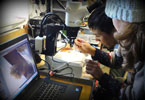CalCOFI workstations rely on a local area network and NAS data server (//seaserv2) to interact and exchange data at-sea. Essential workstations need to be setup & running on the network before the first CTD cast.
The essential workstations are:
- CTDBlade1 - primary CTD data acquisition computer running Windows7, Seasoft v7, CELogGPS event log, & CTDBackup; connected to the CTD deck unit. (Blue denotes CalCOFI in-house software).
- Seasoft (from seabird.com) is used to acquire real-time CTD data.
- CELogGPS runs in the background (or may be run on another nearby/KVM PC) so the CTD operator can generate the CTDatDepth event, recording 'GPS lat lon date time event# & activity' when the first bottle is tripped.
- After tripping the last, surface bottle & the CTD lands on deck, the deck pressure is written on the console ops form; Seasave data acquistion is stopped; the deck unit is turned off; then CTDBackup is run by pressing <Ctrl><Alt>B (shortcut key mapped in Windows to executes the CTDBackup program). This copies all cast files to a flash drive and generates a base file for the seawater sample log, CESL program, running on the wet-lab tablet computer. Note: any corrections to the cast's .mrk file should be done BEFORE pressing <CTRL><Alt>B ie duplicate markers erased or extra bottles without markers added.
- ZTree is used to print the .mrk & .prn files then move the CTD cast files to the archive directory when archiving; printouts are collated & put in the CTD notebook.
- Network color printer connectivity required.
-
CTDBlade2 - backup CTD data acquisition computer running Windows7 and METCapture; able to run Seasoft v7, CELogGPS, CTDBackup, & ZTree quickly if needed for CTD ops. All software settings for Seasoft, CTDBackup, & CELogGPS from CTDBlade1 should be mirrored onto CTDBlade2. When not being used for CTD ops, CTDBlade2 runs:
- METCapture which logs MET/SCS/GPS data to the Events dir on seaserv. METCapture will also generate the currpos.csv used by other event logging workstations on the network.
- pH logger - serial terminal capture program, only if pH is NOT integrated into MET.
- Network color printer connectivity required for CTD backup ops.
-
CESL-Tablet - Windows7, weatherproof tablet in the wet-lab, rosette sampling area runs:
- CESL: CalCOFI Electronic Sample Log program. CESL is used to log all seawater sample information, generate a chl sample filtration form, & analytical base files for use by other workstations-programs.
- CELogGPS may be run in the background for event monitoring & entry.
- Network color printer connectivity required.
-
ROXY (Intel NUC or Moneual-red) - small oxygen autotitrator pc running Windows7.
- Runs an ODF-developed, Labview Oxygen Autotitration program. If available, the autotitrator program will load draw temperatures and flask numbers from the sta 'box' file (###01.box; in the 'O2box' dir). CESL generates this file from the flask & draw T columns when saving the station log; ROXY's O2 box directory needs to be shared & writable over the network by CESL. ROXY's O2 box dir is usually mapped as O:\.
- Network color printer connectivity required.
-
PIC-Laptop - required only for prodo sta; on a networked workstation
- Run Almanac, a simple program that calculates LAN (local apparent noon; called "transit, azimuth:..." in the program) & civil twilight ("civil twilight ends") using the prodo incubation's estimated begin & end latitudes/longitudes.
- In DECODR, run the PIC: Productivity Integration Calculator module; enter the sta# (001-075), LAN & Civil Twilight (from step 1 Almanac output), secchi depth & cast type to generate the prodo experiment bottle depths. PIC will print the bottle depths to a network printer then saves the bottle numbers, adjusted for extra bottles, to the prd### file. CESL uses the prd### to highlight prodo bottles on the sample log. If prodo bottles are not highlighted, the CTD operator has forgotten to label the cast type as "PRODO" in the CTD header form, filled out at the start of the cast. Selecting 'PRODO' in CESL's cast-type box will fix this and load the prd### and highlight the depths.
- Network color printer connectivity required.
- EventLog-Tablet - on New Horizon, a networked, tablet pc running Windows 7 or XP and CELogGPS is mounted vertically (using a clipboard) in the aft-control winch shack. New Horizon crew will log all station activities for us, if requested. Some training of new (& old) crew may be necessary to get things started - update their initials in the initials.txt or watch.txt file (whichever is specified in CELogGPS.cfg). Events are displayed onscreen on all the event log program on the network so CTD operators should monitor entries and be sure all sta activities are recorded. On other ships, the event log tablet is installed near net operations. WiFi may be used if a strong signal is available.
Other workstations on the network:
-
FLog - Chl/Rad van workstation running the chlorophyll analysis program FLog; will preload a chl base file generated by CESL and save chl readings locally & to the chl dir on seaserv.
- Network color printer connectivity required.
- PSal - salt analysis computer running PSal, which will preload a salt base file generated by CESL. PSal will compare the bottle salt sample reading to CTD values from the sta.csv. A Local printer is preferred since PSal buffers each sample record. If desired or no local printer is available, the printfile may be manually printed after the run.
- Nuts - nutrient analysis laptop running SEAL Quattro software does not require a network connection to run nutrient samples. But it is desireable so nutrient data may be copied/backed-up to seaserv's nuts dir during the cruise for data-processing & quality-control. No printer connectivity is required but may also be desired.


